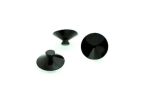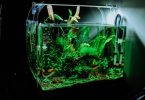Table of Contents
Just because a fish has red eyes doesn’t mean there is a problem. Some fish breeds – such as the red-eyed tetra fish – are prized for their red round eyes, which are perfectly normal and healthy.
However, however, red bloodshot eyes in fish of other species can indicate that your fish may be sick.
If you notice red eyes in one or more of your fishes, it is likely that an underlying infection is behind the scene.
This condition can cause your fish to lose its eyes or sight, or even worse, death if it is not treated.
What are the possible causes of this red eyes in fish?
Causes:
Red eyes in fish can result from a number of factors.
1. Ammonia Poisoning
This can happen in an already existing fish tank when a lot of fishes are introduced at almost the same time, or when the filter malfunctions and fails as a result of an electrical failure, it can be due to change in water conditions.
Within a standard condition of water, the level of ammonia is usually non-existent.
There are a number of potential ammonia poisoning causes in the tank, initially via a chemically treated tap.
Many municipal water treatment facilities use chloramine as a disinfectant. But combining that chemical with treated tap water is a surefire way to ruin your aquarium.
Also, excessive feeding and little or no cleanliness lead to the build-up of bacteria that eat this extra substance, resulting in an ammonia byproduct.
Fish also contributes to ammonia poisoning too leading the rise of the levels of ammonia in the tank.
So when a fish feeds there, the building process of protein that enables them grow produces by-products that penetrate the blood of the fishes. This often leads to a leakage of the ammonia poison into the tank and the gills of the fish.
Symptoms of Ammonia Poisoning in Fish
The poison from ammonia can happen instantly for some days. In the beginning, the fish is usually seen swimming up to the surface to gasp air, with their eyes turned red, as though it is bleeding.
More so, in other cases the fish could be at the bottom of the tank and have its fins seem buried.
Also while the poison from the ammonia continues to spread, the tissues from the fish gradually deteriorate and can be made manifest by the patches of blood on the fins of the fish and in its eyes.
One can also notice that the fish starts bleeding externally and internally, and once this happens, the fish dies.
Treatment
Should the level of ammonia in the fish tank rise beyond one part per million using an ideal test kit, it is advised that you begin treating them immediately.
You could begin with reducing the PH level of the water to provide a quick relief, and then change about fifty percent of the water.
Several water changes may be required to happen in a short time frame so that the level of ammonia can be dropped below one part per million.
After this is done, reduce the quantity of feed as well as the feeding routine so that there is a reduction in the amount of waste.
If the ammonia level is very high, kindly stop the feeding process entirely for some days, and do not introduce any new fishes to the aquarium till the nitrite and ammonia drops down to zero.
2. Excessive Nitrate
Excess nitrate is also a major cause, because if the tank or the fishes are open to rising nitrates without any maintenance, the exposure can cause harm to your fish.
Symptoms include;
- Lack of appetite
- Frequent movement of the gill which increases the rate of respiration
- Listlessness
- Always in shock
- Lack of balance
- Curl from head to tail (advanced step)
Treatment includes;
- Make several small water changes
- To reduce the level of the nitrate values for most newly added species, controlled but rapid changes must be made. Inquire the level of the value of nitrate that is recommended for any of the species you are about to introduce to the tank. More so, before the purchase of any new fish examine the water in the tank, and most of all be attentive to the level of nitrate and PH in the water. When you get to the store for aquariums, request that the clerk tests the water so that you are able to confirm that the nitrate level and PH level of the water are close to what is obtainable in your environment.
- Use filter media that removes nitrates. Should the level of nitrates become reoccurring problems, remove the filter media to help control the level.
- Feed less. Endeavour that you feed the fishes enough to stay healthy, and the level of nitrates should be constantly controlled and left at the natural level.
3. Septicemia
What is septicemia and how do fish get infected? Septicemia is an infection located in the bloodstream through consuming foods infected with bacteria.
Symptoms:
There may be redness at the base of the fish’s fin, streaks of blood all over the fins as well as the body, there could also be tiny hemorrhages in the eye area, dull behaviour, and a lack of appetite.
Some causes include
The systematic infections of bacteria that is caused by various bacteria like the vibrio, the aeromonas, and the pseudomonas; they get into the bloodstream, spread across the tissues and cause inflammations and damages. More so, bad water, infestation of parasites and a whole lot of infections can lead this illness.
The blood vessels that are inflamed are quite visible at the base of the fin and the skin.
Damages from the blood vessels and tissues in the heart can result in the leaking of fluids from the body to the stomach area or abdomen, which often leads to dropsy.
Treatment:
Examine the treatment given to the water with kanacin or the tetracycline and the food that has been medicated before the fish eats it.
Should there be lots of parasites, the entire tank should be treated with anti-parasite drugs. It may be helpful to use salt to help restore osmotic balance.
4. Bacterial Infection
They often follow parasitic infection, abrasion and visible wound, which can also be an adverse effect of overexposing them to a low diet and bad water. Another common reason is the elimination of the fish’s membrane during netting.
This infection can be seen through different ways, however the most known sign is the appearance of white film around the body and the fins of the fish, red eyes, cracked fins, and hemorrhaging.
Treatment
- To treat, aquarists can use praziquantel, levimasol, and metronidazole. Praziquantel and metronidazole are very effective especially if they are introduced in soluble food, these treatments should be used with caution so as not obstruct the tank’s biological filter.
5. Overstocked Aquarium
Another possible cause of red eyes in fish is that the tank is overstocked and there isn’t enough media to break down the ammonia.
When starting out, it can be tough to tell if your fish tank is too crowded with too many inhabitants.
Knowing a few key points will help you determine if your fish tank is overstocked.
- Stress
- Bullying
- Nitrates, ammonia, and hazy water all contributed to poor growth conditions.
- Oxygen-starved fish due to algae blooms
- Weird Patterns of Behaviour
- Insufficient filtration of fish waste
There is a direct correlation between the number of fish in a tank and the quality of life for those fish; if you overstock the tank, not only will it be more difficult to care for, but the fish will suffer.
This may also lead to the demise of other fish species.
How to prevent red eyes in fish
- Keep the tank clean. Keeping your tank clean can really help in reducing nitrates. Immediately remove all uneaten food. Clean water is usually the best medicine for any fish disease. One thing to consider is the quality of the food you feed your fish, good quality food helps maintain water quality too!
- Perform regular filter maintenance. Frequenting cleaning go a long way in keeping nitrates away.
- Don’t overstock your aquarium.
- Use filter media that removes nitrates.
Also, when you notice a red-eyed fish it is best that you quarantine it to avoid spreading it to other fish. Once these diseased fish are still in the tank, it can affect your entire aquarium and kill all your fish! So without any doubt, it is absolutely necessary to keep the new fish separately.
How to quarantine red eye fish
1.Equip your tank
Get yourself a quarantine tank of at least 10-20 gallons in size. Invest in a filter, heater, power head to stir up the surface, and fish net to maintain clean water and prevent disease in your main aquarium’s inhabitants.
If you don’t already have one, it’s a good idea to invest in a test kit that measures pH, ammonia, nitrates, and nitrites in aquarium water.
Larger fish require more tank space while in quarantine.
2. Fill up the tank with water.
Warm water should be used to clean the quarantine tank before any water is added. Make sure to store it somewhere dim to keep it cool.
After that, fill the quarantine tank with water from your main tank. This can help your fish adjust to their new home more rapidly.
When cleaning the tank, avoid using soap because the chemicals can be harmful to the fish.
Refill the main tank with distilled water that you’ve treated to mimic the properties of the tank water.
3. Consider your quarantine tank as a extension to your primary tank.
Install the tank’s filter, heater, and power head. You can make your fish more at ease in their new home by providing them with decorations and hiding places.
4. Evaluate the environment in the quarantine tank.
Turn on the power head and let the filter run through its cycles to aerate and purify the water in the holding area.
Take a reading to make sure the water is at the same temperature as the main tank. Check the pH level with your test kit to make sure it is consistent with the main tank.
Keep your fish and their offspring healthy by simulating the conditions of their main tank as closely as possible in the quarantine tank.
5. Take the fish out of the main tank.
Transferring fish? Fill a plastic bag with aquarium water and place them inside. Choose the fish you want to quarantine and place it in the plastic bag using the new net from the new tank.
Keep new fish in their plastic bags to prevent any shock.
6. Get your fish used to being in the quarantine tank.
Do not remove the bag from the water for at least 15 minutes to give the fish time to adjust to the new temperature.
Treatment and return of quarantined fish
1. Closely monitor the fish’s vitality and health for 3-4 weeks while they are in quarantine.
Keep an eye out for any red flags that could indicate a problem in the quarantine breeding tank, as this will allow for faster action in terms of both tank removal and treatment;
- Velvety white spots all over the body.
- Problems with missing scales or broken fins
- Eyes that are swollen or cloudy
- Ailments such as sores and ulcers
- Shaking, shallow breathing, and gasping at the surface
- Inconsistent Strokes
- Listlessness
2. Treat any illness.
Choose the best course of action for treatment if one of your fish in quarantine becomes ill.
This can involve doing things like cleaning the water or enhancing its quality by giving fish medicine.
To ensure the fish can recover without further complications, extend the quarantine period by at least two weeks after treatment commences.
Once the fish appears to be healthy, place it in quarantine for another week.
3. Return the fish to the main aquarium.
Once you’ve determined that your fish is healthy, you can take it out of the quarantine tank using a new net. Put the fish and water from the main tank into the plastic bag.
The fish must remain in the sealed plastic bag for at least ten to fifteen minutes before being released into the main tank.
Quarantine water may still contain drugs that could kill other fish, so don’t put it in the main tank.
4. When the quarantine period is over, clean the tank and all the tools you used.
In the tank, dissolve 200 milligrams of bleach in one liter of water. In larger tanks, you should use more. Tank surfaces and machinery can be cleaned using the bleach solution, which should then be rinsed with clean water.
Air drying the tank and tools is recommended to eliminate any remaining bacteria. The tank should then be placed in a dry, clean area of your house.
Conclusion
There you have it, how to get rid of red eyes on fish.







